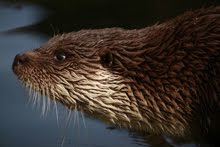Migration time is, once again, an absolute fascination to me.
I cannot seem to find a swift anywhere but the swallows are filling the skies. On Sunday (7 Sept), I awoke to streams of Sand Martins (Riparia riparia, Uferschwalbe) zipping past the roof window above our bed. Later on that day, we came across a flock of about 300 Sand Martins circling and feeding over Kematen.

There are also lots of Barn Swallows (Hirundo rustica, Rauchschwalbe) about. I expected to see hoardes of them sitting on telephone lines along the fields, but so far they have seemed rather intent on moving through and feeding. There have been lots flying about slightly higher than normal, feeding at about 200-400m or so. But they always seem to be moving.
And I cannot believe just how many Phylloscopus warblers there are about at the moment. On Sunday we went for a little wander about the lake in Seefeld. It seemed like every second reed stem and every third willow branch had a couple of Willow Warblers (Fitis) or such like dripping off of them! There are still some Wood Warblers (Waldlaubsänger) and Chifchafs (Zilzalp) about, but they are uncharacteristically silent, and I haven't seen a Bonelli's Warbler (Phylloscopus bonelli, Berglaubsänger) in a while. I am still hoping for an Icterine Warbler (Hippolais icterina, Gelbspötter) to show itself on the way through - I dipped on them on the Spring migration this year, only hearing them a couple of times but never managing to see one.
 This weekend, I will finally get to do some ringing in Tirol! We are going to be setting up nets as part of the GEO biodiversity day (GEO Tag der Artenvielfelt) along the Isar River near Scharnitz. Not sure what (or if) we will catch, but it is on the forest edge so I am hoping for some of those little Phylloscopus, but some tits woul
This weekend, I will finally get to do some ringing in Tirol! We are going to be setting up nets as part of the GEO biodiversity day (GEO Tag der Artenvielfelt) along the Isar River near Scharnitz. Not sure what (or if) we will catch, but it is on the forest edge so I am hoping for some of those little Phylloscopus, but some tits woul d be nice too. Apparently, the tits are notorious biters (especially the Blue Tit Cyanistes caeruleus Blaumeise). I am looking forward to seeing just how true this is or whether it is just a (sub)urban legend. I can't imagine they bite anything like the notorious Thickbilled Weaver (Amblyospiza albifrons, Weissstirnweber, the photo is from MBoy68's Flickr photostream).
d be nice too. Apparently, the tits are notorious biters (especially the Blue Tit Cyanistes caeruleus Blaumeise). I am looking forward to seeing just how true this is or whether it is just a (sub)urban legend. I can't imagine they bite anything like the notorious Thickbilled Weaver (Amblyospiza albifrons, Weissstirnweber, the photo is from MBoy68's Flickr photostream).
It is bound to be a lot of fun so, if you are in the area and are interested in taking part in the various activities, then just check out the official website and come along!
I cannot seem to find a swift anywhere but the swallows are filling the skies. On Sunday (7 Sept), I awoke to streams of Sand Martins (Riparia riparia, Uferschwalbe) zipping past the roof window above our bed. Later on that day, we came across a flock of about 300 Sand Martins circling and feeding over Kematen.

There are also lots of Barn Swallows (Hirundo rustica, Rauchschwalbe) about. I expected to see hoardes of them sitting on telephone lines along the fields, but so far they have seemed rather intent on moving through and feeding. There have been lots flying about slightly higher than normal, feeding at about 200-400m or so. But they always seem to be moving.
And I cannot believe just how many Phylloscopus warblers there are about at the moment. On Sunday we went for a little wander about the lake in Seefeld. It seemed like every second reed stem and every third willow branch had a couple of Willow Warblers (Fitis) or such like dripping off of them! There are still some Wood Warblers (Waldlaubsänger) and Chifchafs (Zilzalp) about, but they are uncharacteristically silent, and I haven't seen a Bonelli's Warbler (Phylloscopus bonelli, Berglaubsänger) in a while. I am still hoping for an Icterine Warbler (Hippolais icterina, Gelbspötter) to show itself on the way through - I dipped on them on the Spring migration this year, only hearing them a couple of times but never managing to see one.
 This weekend, I will finally get to do some ringing in Tirol! We are going to be setting up nets as part of the GEO biodiversity day (GEO Tag der Artenvielfelt) along the Isar River near Scharnitz. Not sure what (or if) we will catch, but it is on the forest edge so I am hoping for some of those little Phylloscopus, but some tits woul
This weekend, I will finally get to do some ringing in Tirol! We are going to be setting up nets as part of the GEO biodiversity day (GEO Tag der Artenvielfelt) along the Isar River near Scharnitz. Not sure what (or if) we will catch, but it is on the forest edge so I am hoping for some of those little Phylloscopus, but some tits woul d be nice too. Apparently, the tits are notorious biters (especially the Blue Tit Cyanistes caeruleus Blaumeise). I am looking forward to seeing just how true this is or whether it is just a (sub)urban legend. I can't imagine they bite anything like the notorious Thickbilled Weaver (Amblyospiza albifrons, Weissstirnweber, the photo is from MBoy68's Flickr photostream).
d be nice too. Apparently, the tits are notorious biters (especially the Blue Tit Cyanistes caeruleus Blaumeise). I am looking forward to seeing just how true this is or whether it is just a (sub)urban legend. I can't imagine they bite anything like the notorious Thickbilled Weaver (Amblyospiza albifrons, Weissstirnweber, the photo is from MBoy68's Flickr photostream).It is bound to be a lot of fun so, if you are in the area and are interested in taking part in the various activities, then just check out the official website and come along!






.jpg)



.jpg)








.jpg)



No comments:
Post a Comment